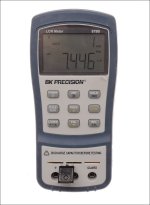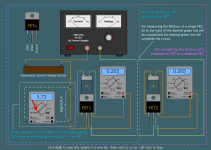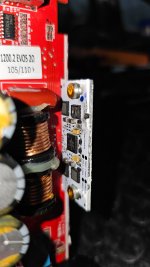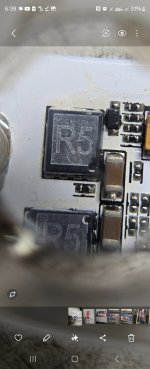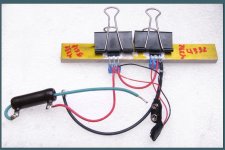Hello lads.
I'm repairing these amplifiers, as long as it involves repairing the power supply I have no problem, but if it involves repairing the audio section we don't know what the output mosfets with code R6 or R7 or R8 actually are.
do any of you have any ideas?
I'm repairing these amplifiers, as long as it involves repairing the power supply I have no problem, but if it involves repairing the audio section we don't know what the output mosfets with code R6 or R7 or R8 actually are.
do any of you have any ideas?
There is a lot of speculation and people find FETs that will survive but I know of no one doing any testing to find a good match. If no one can answer definitively, I can go into more detail.
Do you have any of the original FETs that survived?
Do you have any of the original FETs that survived?
Yes perry, i have 3 of 4 survived.
Now im using csd19534q5a and the amp work at 4ohm (2ohm stereo) but if I use 2ohm load (that is the minimum reccomended load) the amp cut off prematurely....probably because the irs2052 OC trip with this devices
Now im using csd19534q5a and the amp work at 4ohm (2ohm stereo) but if I use 2ohm load (that is the minimum reccomended load) the amp cut off prematurely....probably because the irs2052 OC trip with this devices
To confirm that it's the over-current programming, you could run one channel at a time and move the new FET to the channel with all surviving FETs to see if it causes the same problem in that channel. Move one of the survivors to the blown channel to confirm normal operation.
There are several tests to compare the original and the new replacement. The simplest is the capacitance of the two FETs. Measure with the gate and drain directly connected then check capacitance from those to the source terminal. Then connect drain and source and measure gate to the drain/source (attached). This needs to be done out of the circuit. Does the capacitance of old and new match (relatively close)?
The second test (inside blue square below) would be to connect the FET to a current limited power source. I use a 2 ohm resistor. You would use more resistance for low-rated FETs. You also need to apply a gate/source voltage of 9-10v (I use 9v batteries). The gate/source drive needs 100% isolation from the main power source (especially more important later). Drive the limited current through the FET and measure the drain/source voltage and the current flow through the FET. Use those and calculate the RDS(on) with V=IR or R=V/I.
Do this with old and new FETs. The FETs need to be on some sort of heatsink when doing this. If you use the heatsinking of the board in the amp, the circuit needs to be completely open to all other components. I've only done this with TO-220 and larger FETs.
When you find two very comparable FETs (old and new), you would connect the FETs in direct series (so each has exact same current flow) and measure the VDS(on) of each while in series.
It's also possible to reprogram the over-current protection but that can be more difficult to get right.
There are several tests to compare the original and the new replacement. The simplest is the capacitance of the two FETs. Measure with the gate and drain directly connected then check capacitance from those to the source terminal. Then connect drain and source and measure gate to the drain/source (attached). This needs to be done out of the circuit. Does the capacitance of old and new match (relatively close)?
The second test (inside blue square below) would be to connect the FET to a current limited power source. I use a 2 ohm resistor. You would use more resistance for low-rated FETs. You also need to apply a gate/source voltage of 9-10v (I use 9v batteries). The gate/source drive needs 100% isolation from the main power source (especially more important later). Drive the limited current through the FET and measure the drain/source voltage and the current flow through the FET. Use those and calculate the RDS(on) with V=IR or R=V/I.
Do this with old and new FETs. The FETs need to be on some sort of heatsink when doing this. If you use the heatsinking of the board in the amp, the circuit needs to be completely open to all other components. I've only done this with TO-220 and larger FETs.
When you find two very comparable FETs (old and new), you would connect the FETs in direct series (so each has exact same current flow) and measure the VDS(on) of each while in series.
It's also possible to reprogram the over-current protection but that can be more difficult to get right.
Attachments
Thanks perry, as always you are a wealth of knowledge.
Unfortunately, however, this method cannot be used because I am working with VSONP-8 package mosfets which are soldered directly onto an aluminum plate (which contains the entire driving circuit, including irs2052 and all the resistors and capacitors that compose it) which in turn comes into contact with the main heat sink.
Unfortunately, however, this method cannot be used because I am working with VSONP-8 package mosfets which are soldered directly onto an aluminum plate (which contains the entire driving circuit, including irs2052 and all the resistors and capacitors that compose it) which in turn comes into contact with the main heat sink.
Attachments
If you can solder/desolder the FETs to replace them, you could do it. It's not quite as easy but it could be done.
Hopefully someone will have a direct replacement for you.
Hopefully someone will have a direct replacement for you.
Very interesting!Here is the R5 number for you as well.
BSC098N10NS5
It's incredible how and why certain companies go to such great lengths to keep state secrets about the components used in their amplifiers and then let certain information leak out by badly scratching the surface of some of their own mosfets.
But what the hell is the reason why they hide?
If I buy an amplifier, then afterwards I am free to do what I want with it, to break it, to repair it, in the end, even if they hide, we still find a solution, whether it's the original number as in this case, or an alternative that works well.
It would be even more interesting to create a collection of this information, to allow those in charge to carry out their own repairs.
It's not fair that if my amplifier breaks, afterwards I just have to throw it in the dumpster.
In my opinion, it's pure evil. There is no design engineer that can't reverse engineer any circuit. The only thing that can be difficult is the firmware of an MCU or EEPROM. The only people they hurt are the owners and the service techs. The 'right to repair' was supposed to apply to consumer electronics but it's being slow-rolled.
I totally agree, but even if you do reverse engineering, if the component is deleted, how can you still get it?
At most you can select one that might be good, but in reality you will not be sure, unless you redo all the necessary calculations that are often not enough to guarantee reliability.
In the end it is really counterproductive, because if you gave the possibility of repairing the amplifier, an economic return would be guaranteed to the company, which by offering seriousness, will keep its loyal customers, on the contrary, if you cause me a similar problem, I will go to another company that instead collaborates without problems.
One thing is certain, if my amplifier breaks and I cannot repair it, I will certainly not buy from that company again.
At most you can select one that might be good, but in reality you will not be sure, unless you redo all the necessary calculations that are often not enough to guarantee reliability.
In the end it is really counterproductive, because if you gave the possibility of repairing the amplifier, an economic return would be guaranteed to the company, which by offering seriousness, will keep its loyal customers, on the contrary, if you cause me a similar problem, I will go to another company that instead collaborates without problems.
One thing is certain, if my amplifier breaks and I cannot repair it, I will certainly not buy from that company again.
For the most part, people don't think logically. If they see cheap and it's instant gratification, they will buy cheap, regardless of previous experience.
Testing for larger FETs is a breeze after you make up the test jig. The most expensive parts (attached) are the 9v batteries I use (cheaper than power supplies if you don't already have isolated supplies). Most shops already have items that they can work with and buy nothing more. It takes about 2-3 minutes to test/change/test FETs.
Testing for larger FETs is a breeze after you make up the test jig. The most expensive parts (attached) are the 9v batteries I use (cheaper than power supplies if you don't already have isolated supplies). Most shops already have items that they can work with and buy nothing more. It takes about 2-3 minutes to test/change/test FETs.
Attachments
- Home
- General Interest
- Car Audio
- R6 - R7 - R8 soundigital evo5 output mosfet
